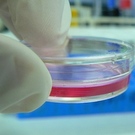
Good morning, myeloma world. Welcome to a new feature here at The Myeloma Beacon: Myeloma Morning.
Starting today, you can come to The Beacon every morning of the week, and a new edition of Myeloma Morning will be waiting for you. Each edition will include summaries of the latest myeloma-related research and myeloma-related news from the business world. We'll also make sure to keep you posted on any interesting conversations going on in the Beacon's myeloma discussion …
Read the full story »

A solvent used extensively for both industrial as well as pharmaceutical purposes may have substantial anti-myeloma activity.
This is the conclusion of a recent study by an international team of researchers, which carried out a wide range of pre-clinical investigations of the solvent N-methyl-2-pyrrolidone (NMP).
The scientists looked at the effect of NMP on myeloma cells in laboratory cultures as well as in mice implanted with myeloma cells. Their testing indicates that safe doses of NMP may have anti-myeloma activity …
Read the full story »
Siltuximab, a drug that has been tested as a potential new treatment for multiple myeloma, was approved last week by the U.S. Food and Drug Administration (FDA).
Its approval, however, was as a new treatment for a form of Castleman's disease, a rare disorder similar to lymphoma.
Siltuximab will be marketed in the United States by the Janssen Biotech division of Johnson & Johnson (NYSE:JNJ). The drug's brand name will be Sylvant.
Johnson & Johnson also has submitted an application …
Read the full story »

Significant improvements in donor stem cell transplantation have been made in recent years. As a result, donor transplantation – a procedure during which a patient receives stem cells from a healthy donor – has become safer and typically more successful for patients.
The majority of patients undergoing donor stem cell transplantation receive stem cells from unrelated donors. In these cases, a close match between donor and recipient tissue types is known to play an important important role in transplant outcomes. …
Read the full story »
In a recent study conducted in Korea, investigators found that myeloma patients who had higher weights at diagnosis had the longest survival.
Patients who were underweight at diagnosis, on the other hand, had the lowest survival.
The results of the Korean study are similar to those reported by a recent study that examined weight at diagnosis and its impact on survival in U.S. veterans diagnosed with myeloma (see related Beacon news).
In the Korean study, investigators retrospectively analyzed data for …
Read the full story »
Researchers at the University of Miami's Sylvester Cancer Center have started a Phase 2 clinical trial to test whether the cholesterol drug fenofibrate (Tricor) is effective, on its own, as an anti-myeloma therapy.
The trial is motivated by a preclinical study, which found that fenofibrate is toxic to multiple myeloma cells. In particular, fenofibrate appears to interfere with the ability of myeloma cells to purge themselves of proteins they produce. The proteins eventually accumulate within the cells to levels that …
Read the full story »

This year’s meeting of the American Society of Clinical Oncology (ASCO) was held May 31 through June 4 in Chicago.
During the meeting, The Beacon published daily updates that provided overviews of the important multiple myeloma findings presented during the meeting.
Now that the meeting has concluded, the focus shifts to the bigger picture: What were the key findings of the meeting? Were there results with immediate implications for the treatment of multiple myeloma? Did the research …
Read the full story »

